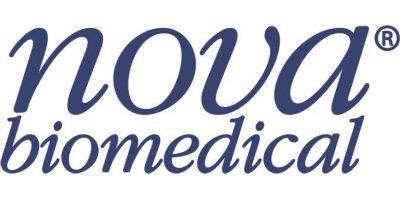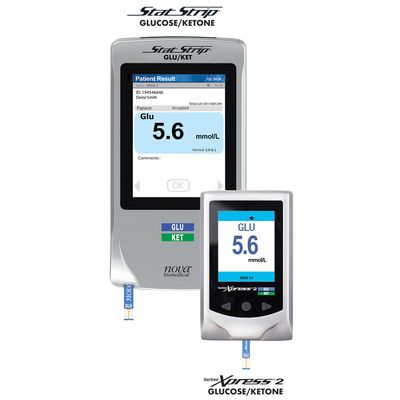


Nova - Model StatStrip® and StatStrip Xpress®2 - Glucose/Ketone Meters
The most extensively studied and proven glucose measurement technology. In addition to studies submitted to the FDA, 168 other independent studies over the last eight years—including 53 critical care studies—have found no clinically significant interferences for StatStrip`s measurement technology. This is a statement that no other glucose meter manufacturer can make. StatStrip and StatStrip Xpress2 are the world’s most extensively studied and proven glucose test. It has been proven to be safe and effective for use throughout all hospital and professional healthcare settings including critical care.
The StatStrip Glucose/Ketone Hospital Meter System offers bidirectional wireless connectivity to hospital HIS or LIS with complete security to protect patient data.
- Wireless connectivity can transmit patient results directly from the bedside, alleviating the need to bring the meter to a fixed location for meter docking and data transmission.
- Wireless connectivity saves time for the caregiver and allows for faster charting of results and clinical decision making to improve patient care.
- Dual-band wireless connectivity provides complete security and encryption to ensure that patient data remains uncompromised.
- Nova now offers a full range of StatStrip Glucose/Ketone wireless connectivity capabilities, including wireless meters, wireless carrying cases, and wireless docking stations.
- All wireless devices use the industry standard POCT1-A2 data format and are compatible with a choice of middleware partners.
Easy to use
No meter preparation or calibration coding steps are required. Insert a ketone strip and StatStrip Glucose/Ketone meter automatically recognizes the strip and converts the meter to ketone measuring mode.
Blood ketone testing should be performed whenever glucose exceeds 14 mmol/L (250 mg/dL)
Diabetes UK, the Canadian Diabetes Association, the European Society for Paediatric Endocrinology, and the American Diabetes Association (ADA) recommend that blood ketone testing be performed whenever glucose exceeds 14 to 17 mmol/L for rapid detection or prevention of diabetic ketoacidosis (DKA).
StatStrip Glucose/Ketone measures blood beta-hydroxybutyrate, the preferred ketone for diagnosing ketoacidosis
According to the European Society for Paediatric Endocrinology, Diabetes UK, ADA, and others, blood ketone testing methods that quantify beta-hydroxybutyrate, the predominant ketone body in DKA, are recommended over urine ketone testing for diagnosing and monitoring ketoacidosis.
Ketone testing results obtained from capillary samples
Capillary blood samples are not only preferred over urine samples to detect and monitor DKA,
they are also easier to obtain and allow for immediate reflex testing of ketones whenever glucose is greater than 14 mmol/L.
Blood ketone monitoring reduces costs and ICU length of stay for DKA patients
An ICU study evaluated the effectiveness of blood ketone testing versus urine ketone testing for DKA patients. The blood ketone testing group of patients left the ICU 6.5 hours earlier than the urine ketone testing group. This led to savings of 22 hours of nursing time and 375 laboratory investigations, for a total savings of €2,940.1
A second study of DKA patients compared a DKA therapy endpoint of pH > 7.3 and blood ketones < 1.0 mmol/L, versus an endpoint of pH > 7.3 and negative urine ketones. The pH/ blood ketone endpoint was reached after 17 hours, whereas the pH/urine ketone endpoint was not reached until 28 hours after starting treatment. The mean lag between the blood ketone and urine ketone groups was 11 hours, ranging from 1 to 36 hours.2
Blood ketone is more accurate than urine ketone testing
Blood beta-hydroxyburyrate testing indicates the patient’s status at the time of the test, whereas urine may have been in the bladder for several hours. Urine testing can also produce false positive or negative results due to highly colored urine, highly acidic urine, exposure of the urine test strips to air for prolonged periods, drugs such as the ACE inhibitor captopril, or high doses of vitamin C.
*Ketone testing is not available with StatStrip meters in the U.S. Glucose is available.
Learn more
In order to help hospitals avoid the risk of glucose meter off-label use, Nova Biomedical’s technical support resources are ready to help you acquire the StatStrip Glucose Hospital Meter System. To learn more about how StatStrip Glucose can bring critical care testing to the bedside, contact your current GPO or call Nova at 800-458-5813.
Weight: 0.49 lb (220 g)
Size: 5.8 in x 3.1 in x 1.18 in
(147 mm x 79 mm x 30 mm)
Glucose and Ketone Testing in One Meter (ADA recommends ketone testing when glucose >250 mg/dL or >14 mmol/L)
- Glucose Results in 6 Seconds, Ketone Results in 10 Seconds
- 1.2 Microliter Sample for Glucose
- 0.8 Microliter Sample for Ketone
- Simple, Color Touchscreen Operation
Data Storage:
Patient Tests: 1,000 tests
QC Tests: 200 tests
Users: 8,000 users
Connectivity:
Meter Data Output: RJ-45 Ethernet Port
Protocol: TCP/IP Ethernet 100 Mbit Standard: POCT1-A2
Compliant Setup Program: NovaNet™ Web-Based Instrument Manager Software
Battery Information:
Type: 3.7V Li Polymer Rechargeable Battery
Features: Rechargeable/Replaceable
Life: 6-8 hours in use (approximately 40 tests w/barcode scans)/12-24 hours standby
Docking Station:
Optional accessory; desk or wall mount charging station with RJ-45 Ethernet jack. 3 LED indicator lights showing connection status, transmit/receive data, and charging status. Extra battery slot included for recharging and storage of spare battery.
Additional Features:
- Color touchscreen
- Built-in barcode scanner
- Traditional QC with target values assigned to QC materials
- Numeric or pass/fail QC
- QC prompting or QC lock out
- Abnormal and critical ranges flagged by color highlighting
- Canned or free text user comments
- Reject of results at meter (optional) for repeat testing
- Flag Tight Glycemic Control results
- Accept patient ID or accession number
- Use of operator password (lockout)
- Entry of offline tests
- Entry of ICD-9 diagnosis codes
- Order physician ID
- Onscreen training mode
- Correlation mode
- Slope and intercept adjustment
- Web-based meter configuration by location
- Custom meter configuration by medical unit
- Connect to hospital ADT
- Connect to all LIS/EMR
- POCT1-A2 data output
